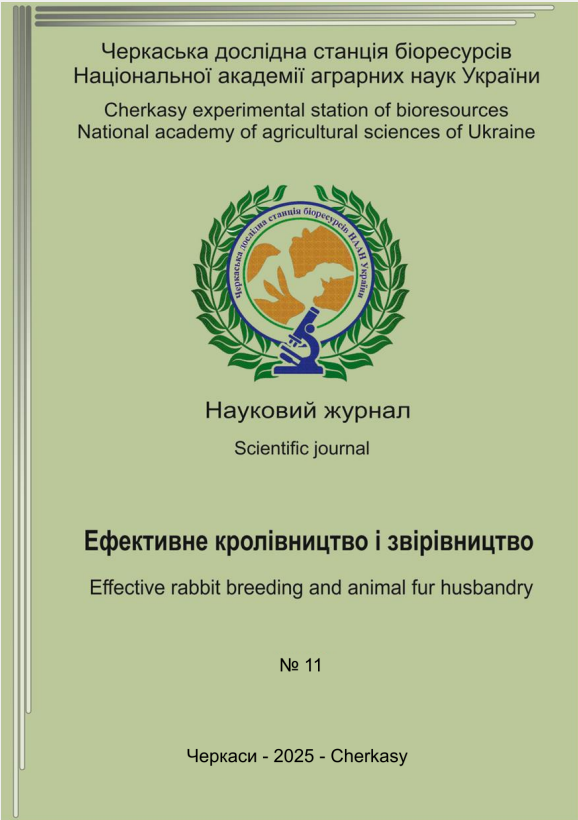Genetic potential of Poltava silver rabbits: G-BLUP evaluation based on polymorphism of MSTN and PGR genes
DOI:
https://doi.org/10.37617/2708-0617.2025.11.19-27Keywords:
rabbits, G-BLUP, genes, myostatin, progesterone receptor, Poltavska Silver breedAbstract
The article presents the results of the assessment of rabbits of different lines of the Poltava Silver breed using the G-BLUP method with the analysis of the influence of polymorphic variants of the myostatin (MSTN) genes on live weight and progesterone receptor (PGR) on reproductive ability.
The indicators of gene diversity in different lines of the Poltava Silver breed for these polymorphisms showed a positive value of the Wright fixation index (Fis), indicating the predominance of heterozygotes for the C and T alleles. Based on the obtained heterozygosity data, Wright fixation indices were calculated.
The inbreeding coefficient (Fis) for the genes – MSTN and PGR – showed different distributions between rabbit lines. A higher value of Fis for the MSTN gene indicates a greater deficit of heterozygosity, potentially indicating higher inbreeding effects. On the other hand, a lower value of Fis for the PGR gene means smaller inbreeding effects or that the population is closer to panmixia.
Analysis of the influence of the SNP C34T polymorphism in the MSTN gene on the average daily gain of rabbits revealed the following patterns. Heterozygous rabbits with the ST genotype demonstrated higher average daily gains. Their gains were 2.3% higher than those of homozygotes for the C allele (39.0 ± 0.3 g vs. 38.2 ± 0.2 g, p<0.05). At the same time, the average daily gains of homozygotes for the T allele were 2.6% lower than those of heterozygotes for the ST (38.2 ± 0.2 g vs. 39.0 ± 0.3 g, p<0.05).
It was found that line 1871817 is the most promising in terms of meat productivity, showing the highest values of BLUP-index (1358), estimated breeding value (EBV, 1.412) and reliability (REL, 1.827), which confirms its high genetic potential. Lines 1847213 and 1832221, on the contrary, have small negative EBV and low REL, which indicates their lower productivity. The G-BLUP method also confirmed the influence of the PGR gene on reproductive traits. Lines 1871817 and 1811231 showed the highest BLUP-index (5.57) for these indicators, which indicates their high potential for transmitting reproductive potential to offspring. In general, the line 1871817 demonstrates high genetic potential both in terms of live weight and the number of weaned rabbits, which makes it a priority in the selection of the best individuals for future breeding programs in rabbit breeding
References
Shah, Ali, Goswami, Naqash. (2024). Enhancing Rabbit Farming Efficiency with Integrated Genomics and Nutritional Strategies. Frontiers in Animal Science. DOI:https://doi.org/10.3389/fanim.2024.1514923
Dorian, Garrick, Jack, Dekkers, Rohan, Fernando, (2014). The evolution of methodologies for genomic prediction, Livestock Science. Vol. 166. 10-18 p. https://doi.org/10.1016/j.livsci.2014.05.031.
Tabet, J.M., Lourenco, D., Bussiman F.et al. (2025). All-breed single-step genomic best linear unbiased predictor evaluations for fertility traits in US dairy cattle. Journal of Dairy Science. Vol. 108, Issue 1. 694-706 p. https://doi.org/10.3168/jds.2024-25281.
Clark, SA, van der Werf, J. (2013). Genomic best linear unbiased prediction (gBLUP) for the estimation of genomic breeding values. Methods Mol Biol.;1019:321-30. https://doi.org/10.1007/978-1-62703-447-0_13.
Mrode, R. A. (2005). &Thompson, R. Linear models for the prediction of animal breeding values. 2nd ed., Wallingford, U. K: CABI Publishing. http://www.cabi.org/cabebooks/ebook/20053196805
Christensen, O. F., Lund, M.S. (2010). Genomic prediction when some animals are not genotyped. Genet. Sel. Evol.; 42:2 https://doi.org/10.1186/1297-9686-42-2
Clasen, J. B., Fikse, W. F., Su, G., Karaman, E. (2023). Multibreed genomic prediction using summary statistics and a breed-origin-of-alleles approach. Heredity. 131. 33 – 42 p .https://doi.org/10.1038/s41437-023-00619-4
Нonchar O.F., Gavry`sh O.M. , Shevchenko Ye.A. (2015) Metody`chni rekomendaciyi z ocinky` pleminnoyi cinnosti kroliv za metodom BLUP. Cherkasy`: Cherkas`ka doslidna stanciya bioresursiv NAAN 2015. – 12 s.
Bojko O.V., Нonchar O.F., Gavry`sh O.M., Shevchenko Ye.A. (2021) Ocinka pleminnoyi cinnosti samciv kroliv porody` poltavs`ke sriblo za metodom BLUP. Metody`chni rekomendaciyi. – Cherkasy`:Cherkas`ka doslidna stanciya bioresursiv NAAN – 2021 – 20 s.
Bashhenko M.I., Bojko O.V., Нonchar O.F., Gavry`sh O.M., Luchy`n I.S, Usenko V.O., Sotnichenko Yu.M. (2921) Udoskonalennya kroliv porody` poltavs`ke sriblo za oznakamy` produkty`vnosti ta ekster'yeru. Metody`chni rekomendaciyi. – Cherkasy`: Cherkas`ka doslidna stanciya bioresursiv NAAN. – 2021. – 17 s.
Нonchar O.F., Bojko O.V., Gavry`sh O.M., Luchy`n I.S., Shevchenko Ye.A. (2024). Metody`chni rekomendaciyi shhodo pidvy`shhennya pokazny`kiv produkty`vnosti kroliv radyans`ka shy`nshy`la zalezhno vid metodiv yiyi sxreshhuvannya z m'yasny`my` porodamy`. Metody`chni rekomendaciyi. – Cherkasy`: Cherkas`ka doslidna stanciya bioresursiv Nacional`noyi akademiya agrarny`x nauk Ukrayiny` – 2024. – 39 s.
Bojko O.V., Gonchar O.F., Gavry`sh O.M., Luchy`n I.S., Terty`chny`j B.V., Yaremy`ch N.V. (2021) Vy`kory`stannya promy`slovogo sxreshhuvannya dlya pidvy`shhennya m'yasnoyi produkty`vnosti. Metody`chni rekomendaciyi. – Cherkasy`: Cherkas`ka doslidna stanciya bioresursiv Nacional`noyi akademiya agrarny`x nauk Ukrayiny` – 2021. – 24 s.
Shevchenko, E. А. (2011). Perspektivi vikoristannya DNK markeriv v krolivnictvi. Tezi dopovidey molodih vchenih ta aspirantiv Kyiv. 10 s.
Gavrish, О. М. (2020). Efektivnist vikoristannya indeksnoi ocinki v sistemi dobory ta vikoristanni pleminnogo pogolivya kroliv porodi poltavske sriblo. Efektivnekrolivnictvo ta zvirivnictvo. V. 6. 38-46 p.
Instrukciya z bonituvannya kroliv – Ofiz. vyd., chinniyvid 25.09.2003 № 351 – К., 2003. 86 s
Gonchar, О. F., Shevchenko, E.А. (2018). Zastosyvannya metodiv genomnoi selekcii pri doslidzenni kroliv novozelandskoi biloi porody. Efektivne krolivnictvo I zvirivnictvo. Cherkasy:. V. 4. 46-55 p.
Arvind, S., Chetan, V., Avinash, M. (2011). molecular cloning and characterization of rabbit myostatin gene. IOVB journal. N 5: 1 – 6 p.
Peiró, R., Herrler, A., Santacreu, M.A. (2010). Expression of progesterone receptor related to the polymorphism in the gene in the rabbit reproductive tract. J. Anim. Sci. 88(2), 421 – 427 p. https://doi.org/10.2527/jas.2009-1955
Fontanezi, L., Tazolli, M., Scotti, E. (2008) analysis of candidate genes for meat production traits in domes tic rabbit breeds. In Proc 9th World Rabbit Congress, Italy, Verona, 79 – 84 p.
Yeh, F. C., Rongcai, Y., Boyle, T. (1999) popgENE. Ver sion 1.31. – Edmonton: Univ. Alberta,. URL: http://www.ualberta.ca/~fyeh/popgene_download.html


